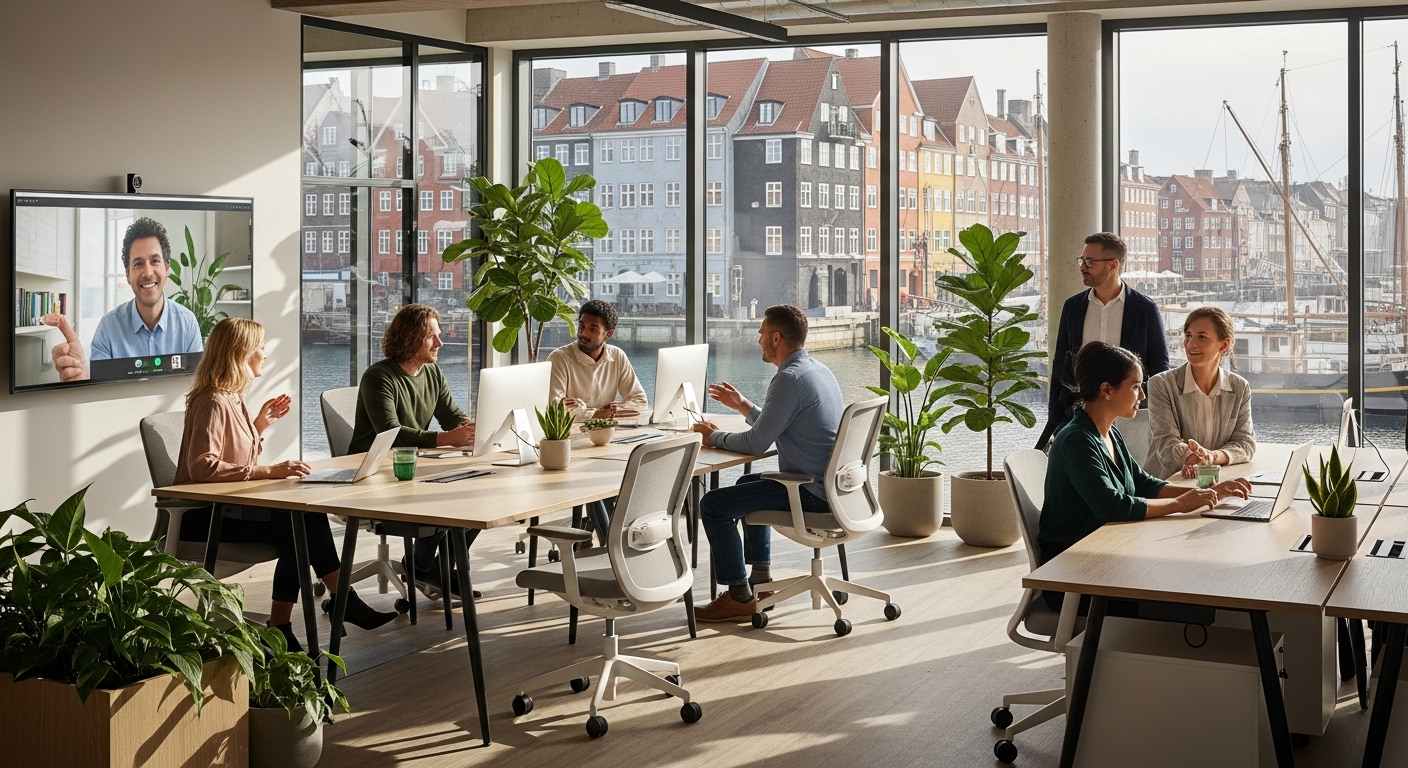The global shift to hybrid work is no longer a temporary adjustment but a permanent fixture of the modern professional landscape. While companies worldwide grapple with creating effective policies, a more nuanced and human-centric approach is emerging from Northern Europe. This model, deeply rooted in a culture of trust and work-life balance, goes beyond simple scheduling flexibility to engineer a system for sustainable productivity and employee well-being. It’s a philosophy that treats hybrid work not as a logistical challenge, but as an opportunity to fundamentally improve how we work. In this context, the Danish concept of arbejdsglæde, or ‘work joy,’ provides a powerful blueprint for success. This guide explores how businesses are leveraging this unique cultural foundation to build hybrid models that foster growth, attract top talent, and set a new global standard for the future of work, with the city of Copenhagen leading the charge.
From Policy to Philosophy: The Foundation of Danish Hybrid Work
The success of any hybrid model hinges on its foundation. In many corporate environments, this foundation is a policy document—a set of rules governing who works where and when. In Denmark, the foundation is a philosophy. The principle of arbejdsglæde is central to the Danish work culture, promoting the idea that happiness and satisfaction at work are not just perks, but essential drivers of productivity and innovation. This cultural underpinning fundamentally changes the conversation around hybrid work. Instead of starting with questions of control and surveillance, Danish companies begin with trust and autonomy. The core assumption is that employees are responsible, self-motivated professionals who, when given the freedom to choose their optimal work environment, will deliver their best work. This approach inherently dismantles the outdated practice of presenteeism, where value is measured by physical presence in an office. Instead, the focus shifts to outcomes, results, and the overall well-being of the team. This trust-based system empowers employees to integrate work into their lives in a way that prevents burnout and fosters long-term engagement. It requires a significant mental shift for leadership, moving from being supervisors to facilitators who provide resources, clear goals, and support, trusting their teams to execute effectively regardless of their physical location. This philosophical alignment is the critical first step in building a hybrid model that is not only functional but truly thriving.
The Office Reimagined: Designing for Purposeful Presence
As the function of work changes, so too must the function of the workplace. In a successful hybrid model, the office is no longer the default location for all tasks. Instead, it becomes a destination for specific, high-value activities that are best performed in person. This is where Copenhagen’s world-renowned design ethos comes into play. Companies are redesigning their physical footprints to be ‘collaboration hubs’—dynamic spaces engineered for connection, creativity, and culture-building. The traditional sea of cubicles is being replaced with a variety of zones tailored to different needs: open-plan areas for brainstorming sessions, soundproof pods for focused individual work or private calls, comfortable lounge areas for informal social interaction, and high-tech conference rooms for seamless collaboration between in-person and remote team members. The goal is to make any time spent in the office intentional and purposeful. Employees come in not because of a mandate, but because the office offers an environment and resources they can’t replicate at home. Forward-thinking companies in Copenhagen are at the forefront of this trend, creating workspaces that act as a cultural magnet, drawing people together to strengthen bonds, spark innovation, and onboard new team members into the company culture. This ‘purposeful presence’ approach respects employee autonomy while ensuring the office remains a vital, value-adding component of the work ecosystem.
Architecting Trust: The Digital and Cultural Scaffolding
Trust is the invisible architecture that holds a hybrid model together. Without it, proximity bias, micromanagement, and a two-tiered culture can quickly emerge, creating division between in-office and remote employees. Building and maintaining this trust requires a deliberate and multi-faceted strategy. Culturally, it starts with leadership. Managers must be trained to lead with empathy, to manage by outcomes rather than by observation, and to communicate with radical transparency. This means establishing clear expectations, defining success metrics that are not tied to an employee’s online status, and creating equitable opportunities for visibility and promotion for everyone, regardless of their location. Digitally, this trust is reinforced through the right technological scaffolding. This involves creating a single source of truth for all projects and communications, ensuring that information is accessible to everyone at any time. It means standardizing communication protocols—for instance, defaulting to public channels over private messages where appropriate—to foster an environment of open dialogue. It also means investing in performance management systems that are fair, objective, and focused on contribution and impact. By consciously designing these cultural and digital systems, organizations can create a level playing field where trust is the default, enabling every team member to feel connected, valued, and empowered to do their best work.
Tech as a Bridge, Not a Barrier: The Copenhagen Stack
In a hybrid environment, technology should serve as a bridge that connects people, ideas, and workflows seamlessly. The goal is to enable flexibility and autonomy, not to create a system of digital surveillance. The ideal ‘tech stack’ for a Danish-inspired hybrid model is one that supports asynchronous work—a cornerstone of respecting employees’ time and focus. While real-time collaboration tools like Slack and Microsoft Teams are essential, they are balanced with powerful project management platforms like Asana, Trello, or Jira. These tools allow for clear task ownership, transparent progress tracking, and communication that doesn’t demand an immediate response, allowing for deep, uninterrupted work. Virtual whiteboarding tools such as Miro or Mural have become critical for replicating the creative energy of an in-person brainstorming session, ensuring remote participants can contribute equally. Furthermore, the emphasis is on integration and simplicity. A cluttered, disjointed tech ecosystem creates friction and frustration. The most effective companies are curating a lean, powerful set of tools that work together harmoniously, minimizing context-switching and maximizing efficiency. The technology serves the culture of trust and autonomy; it doesn’t dictate it. By selecting tools that empower employees rather than monitor them, organizations build a digital environment that mirrors the respect and freedom of the physical one.
Measuring What Matters: Redefining Productivity and Well-being
One of the most significant shifts required by a trust-based hybrid model is the redefinition of productivity. The old metric of ‘hours worked’ is irrelevant and counterproductive. Instead, the focus must move toward a more holistic and meaningful set of indicators that measure true impact and employee health. This starts with clear, outcome-oriented goals, often established using frameworks like Objectives and Key Results (OKRs). This gives teams and individuals a clear understanding of what success looks like, independent of where or when the work is done. However, measuring output is only half the equation. To build a sustainable model, organizations must also measure well-being and engagement. This is done through regular, anonymized pulse surveys that track sentiment, perceived workload, and feelings of connectedness. High retention rates and low levels of employee burnout become key performance indicators for the model’s success. Innovation should also be tracked, whether through the number of new ideas submitted, cross-departmental projects initiated, or process improvements implemented. Businesses in Copenhagen are increasingly adopting this balanced scorecard approach, understanding that long-term growth is inextricably linked to the health and happiness of their workforce. When you measure what truly matters, you create a system that optimizes for both performance and people.
Navigating the Pitfalls: Ensuring Equity and Inclusion
Despite its many benefits, the hybrid model is not without its challenges. The most significant risk is the creation of a two-tiered system where in-office employees are perceived as more committed or have greater access to career opportunities—a phenomenon known as proximity bias. Actively combatting this requires intentional, ongoing effort. One key strategy is to establish ‘hybrid-first’ meeting etiquette, where all meetings are conducted as if everyone were remote. This means every participant joins from their own device, even if they’re in the same room, ensuring a consistent experience for all. Social events and team-building activities must also be designed inclusively, with a mix of in-person gatherings and engaging virtual events so no one feels left out. Career development and mentorship programs need to be structured to deliberately cross location boundaries, pairing mentors and mentees regardless of their work-from-home status. Leaders must be vigilant in how they assign high-visibility projects and provide feedback, ensuring fairness and equal opportunity. The compact geography and strong community fabric of a city like Copenhagen can be an advantage here, making it easier to organize regular, inclusive get-togethers that reinforce a single, unified company culture. By proactively addressing these potential pitfalls, organizations can ensure their hybrid model is not only flexible but also fundamentally fair and equitable for every employee.
In conclusion, the evolution of hybrid work is moving beyond mere logistics and into the realm of cultural philosophy. The model being pioneered in Denmark offers a compelling blueprint for the future, demonstrating that a foundation of trust, a focus on well-being, and a commitment to equity are the true drivers of sustainable growth and innovation. This approach requires more than a new policy; it demands a new mindset from leaders and a re-imagining of the workplace as a hub for purposeful connection. By shifting the focus from presence to performance, from control to autonomy, and from surveillance to support, companies can unlock the full potential of their talent. The Danish emphasis on arbejdsglæde is not a soft perk but a hard-nosed business strategy that builds resilience, attracts top-tier talent in a competitive global market, and creates a workforce that is not only productive but also passionate and engaged. As businesses around the world navigate this new terrain, the lessons from this human-centric approach provide a clear and powerful path forward, proving that the most successful hybrid models are those built for people, not just for profit.





